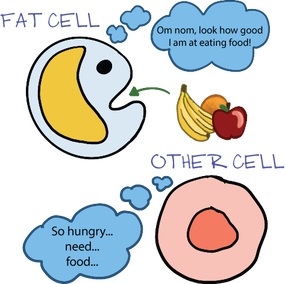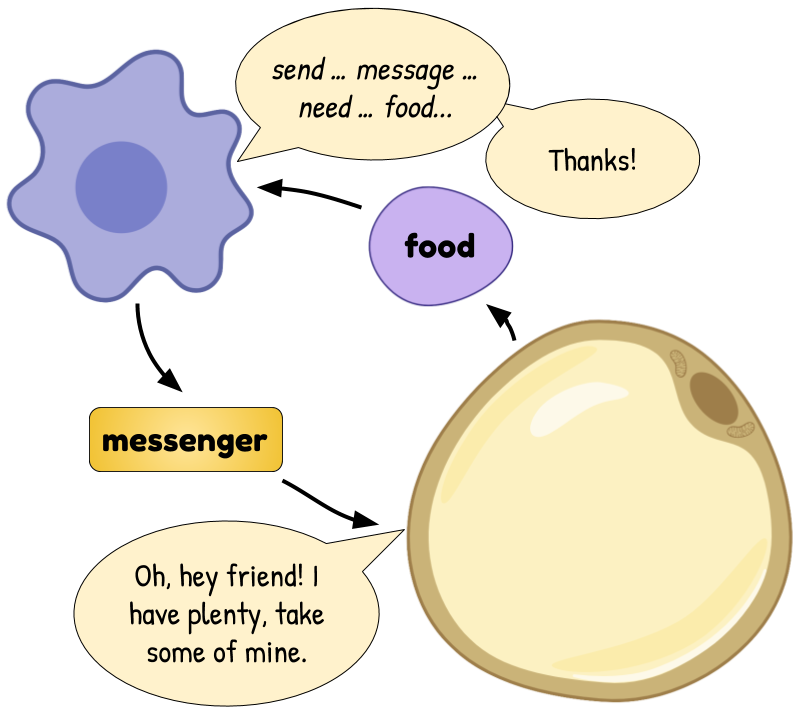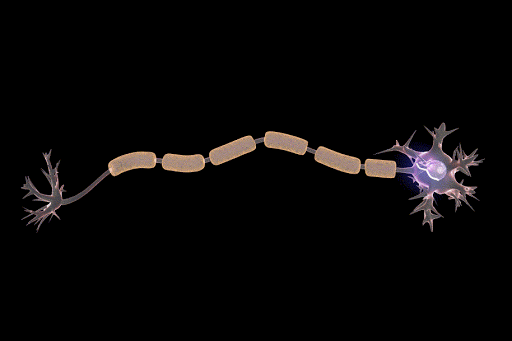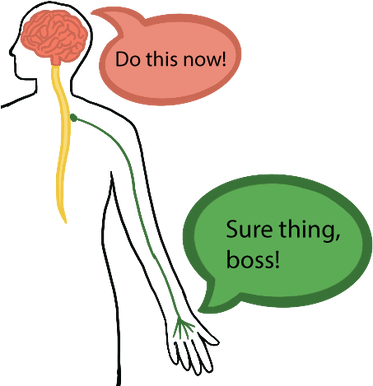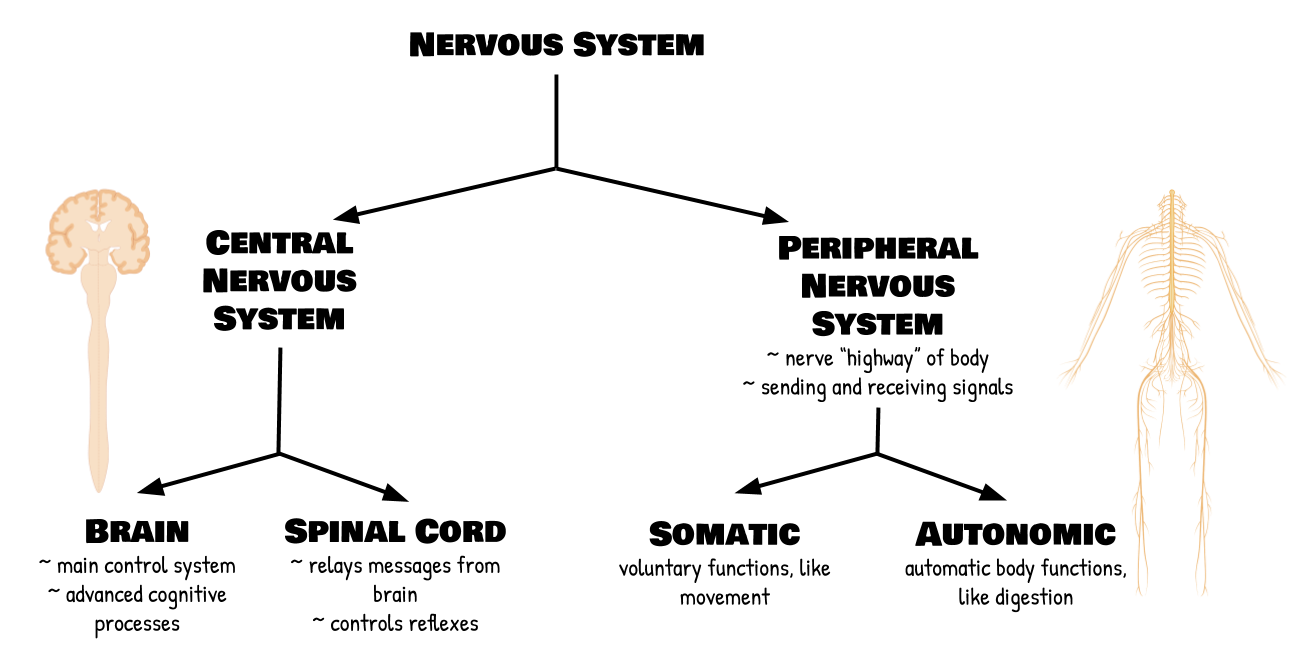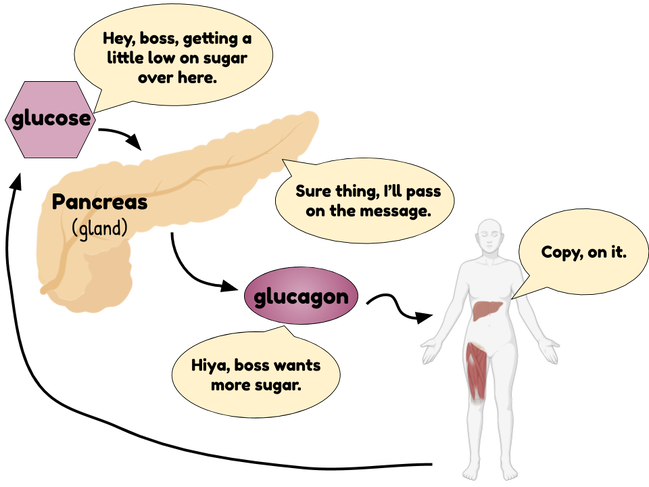the nervous system
communication and control
|
Your body is made up of lots of different cell types, organs, and organ systems that all have their own unique functions that are important to life. As we’ve learned, that diversity of function is important because it lets cells become really specialized (good at doing one thing) and contribute to the overall functioning of the body, even if individual cells are a little, er… less good… at other things. It also presents a new challenge to life, which is that, in order to actually be useful to the overall function of the body, those unique and dispersed cell types need to be able to talk to each other to figure out what needs to get done at any one particular time, and they need a boss who knows the overall goal and can get things done.
|
Our starving cell here needs a way to let the fat cell, which is great at storing food, know that it needs food.
|
|
Think of the body like a clothing factory where everyone has a unique role: one person makes fabric, one person makes buttons, one person makes zippers, one person makes thread, another person stitches zippers to fabric, another stitches the fabric together, another adds buttons, another ships off the final product, a different person designs that product in the first place, and so on. You might have the most amazing fabric-maker in the world, but how does that person know how much fabric to make, or what the design should be? How do the other people know how many buttons, zippers, or spools of thread we need? How do they know where to put the zippers or buttons on the fabric, or how many zippers or buttons to stitch on? How do they know how the fabric goes together? Which pieces of fabric get stitched together? When the final product is ready? The short answer is that these people need to talk to each other, and they need to have some sort of management team that talks to everyone, knows the ins-and-outs of everything that’s happening, knows the big picture, and keeps things moving toward the larger goal of the factory. Otherwise, it would be complete chaos. Effective communication makes all the difference!
|
If our starving cell is able to let the fat cell know that it needs food, the fat cell can send food!
|
The body is the exact same way: In order to work toward a larger goal, cells need to talk to each other, and cells need a central messaging system that understands the larger goals. There are two main systems in the body that are focused on this sort of management and communication: the nervous system, which we’ll talk about in detail this lesson, and the endocrine system, which we’ll talk about in detail in the next lesson. For now, let’s focus on how these systems both contribute to life, how they are similar, and how they are different.
the nervous system: super speedy
The nervous system is for fast, immediate communication. For example, when we want to pull our hand away from a hot stove or engage in a conversation, we rely on our nervous system to send the kind of speedy signals that can keep up with our outside environment. Thinking back to our factory, this would be things along the lines of immediate alerts or alarms, quick messages between employees, or automatic computerized processes.
Super speedy electrical signals like the one pictured below allow the nervous system to send messages really quickly across long distances. For example, one nerve runs all the way down your leg from your lower back! So, every time you twitch your toe or kick a ball, nerve signals are running all the way down your leg within a split second.
Super speedy electrical signals like the one pictured below allow the nervous system to send messages really quickly across long distances. For example, one nerve runs all the way down your leg from your lower back! So, every time you twitch your toe or kick a ball, nerve signals are running all the way down your leg within a split second.
Nervous system communication is also pretty specific: Each electrical signal can usually only tell one or maybe a few cells what to do at a time. This is good sometimes, like when you want only specific muscle cells to contract so that you can walk, move, or talk normally. It’s also bad sometimes, like when you need to tell your heart to beat faster while telling your breathing rate to go up while telling your muscle cells to make more ATP so that you can do something complicated, like run away from a bear. The endocrine system helps with this less-specific kind of communication.
The nervous system also includes the brain, which is like the CEO that knows the big picture of what all needs to happen in your body and oversees the process of making sure that information gets where it needs to go. Your brain, of course, also does a bunch of other really cool stuff besides just managing basic bodily functions, but we won’t talk about the more complex neuropsychological functions of the brain much in this class.
The main branches of the nervous system are called the Central Nervous System (CNS) and the Peripheral Nervous System (PNS). The CNS includes the brain and spinal cord, and it controls all of the nerve processes going on in the body. In the Peripheral Nervous System (PNS), signals are being sent from the spinal cord to the body and back again. This includes autonomic or “automatic” processes, like the ones that control your digestion or breathing when you’re at rest, as well as somatic processes, which are the ones you can do on purpose, like moving your arm or intentionally breathing faster. The PNS is made up of sensory neurons, which send signals to the brain and spinal cord and allow you to sense things (as in, touch, temperature, pain, sights, sounds, smells, tastes, and so on), as well as motor neurons, which send signals from the brain and spinal cord to make you do something, like move your arm.
If you’d prefer that information in rap form, here’s a fun video:
the endocrine system: slow and steady
The endocrine system is for slower, prolonged communication. This is for when you want to tell your body to do something and then keep telling it to do that same thing until it reaches some set end goal. For example, when we want to lower our blood sugar, we rely on the endocrine system to keep telling our cells to take up sugar until our blood sugar is where we want it to be. When we go through puberty, we rely on the endocrine system to tell our bodies to keep changing until they’re fully adult. In the factory, this is sort of along the lines of big company memos, standing protocols, or project managers that check in with you regularly until a project is done.
Finally, endocrine communication can be less specific. Since it’s a chemical being released all over the body, it can tell lots of different cells to do something at once. And, different cell types can perceive this signal different ways, depending on the types of protein signalling molecules that they have. So, like in the example mentioned before, you can tell your heart to beat faster, your lungs to breathe faster, and your muscle cells to make more ATP all at the same time. This is like a big overhead announcement from the body.
Finally, endocrine communication can be less specific. Since it’s a chemical being released all over the body, it can tell lots of different cells to do something at once. And, different cell types can perceive this signal different ways, depending on the types of protein signalling molecules that they have. So, like in the example mentioned before, you can tell your heart to beat faster, your lungs to breathe faster, and your muscle cells to make more ATP all at the same time. This is like a big overhead announcement from the body.
We’ll talk more about the endocrine system later on.
Summary
We’ll talk about each of these systems in more detail soon. For now, focus on the big picture. You should understand:
- That, because the cells in our bodies are so specialized, we need advanced communication systems to keep everything working together.
- That the nervous system is responsible for fast, immediate communication (often less than a second), which we need to respond to quick changes in the environment or string together complex thoughts (think about a slow computer versus a fast one).
- That the central nervous system is like the boss of our bodies. It knows just about everything that needs to happen and is responsible for making sure those things get done.
- That the peripheral nervous system is like the nerve highway system of the body, sending and receiving signals from all over the body.
- This includes autonomic control for automatic body functions, like breathing, and somatic control for voluntary body functions, like movement.
- This includes autonomic control for automatic body functions, like breathing, and somatic control for voluntary body functions, like movement.
- The endocrine system is for slow, prolonged communication, which we need for processes that take place over a longer period of time. This can range from a period of minutes to years.
Learning Activity
Contributors: Megha Kori, Emma Moulton
Some images made with biorender.com
Some images made with biorender.com
